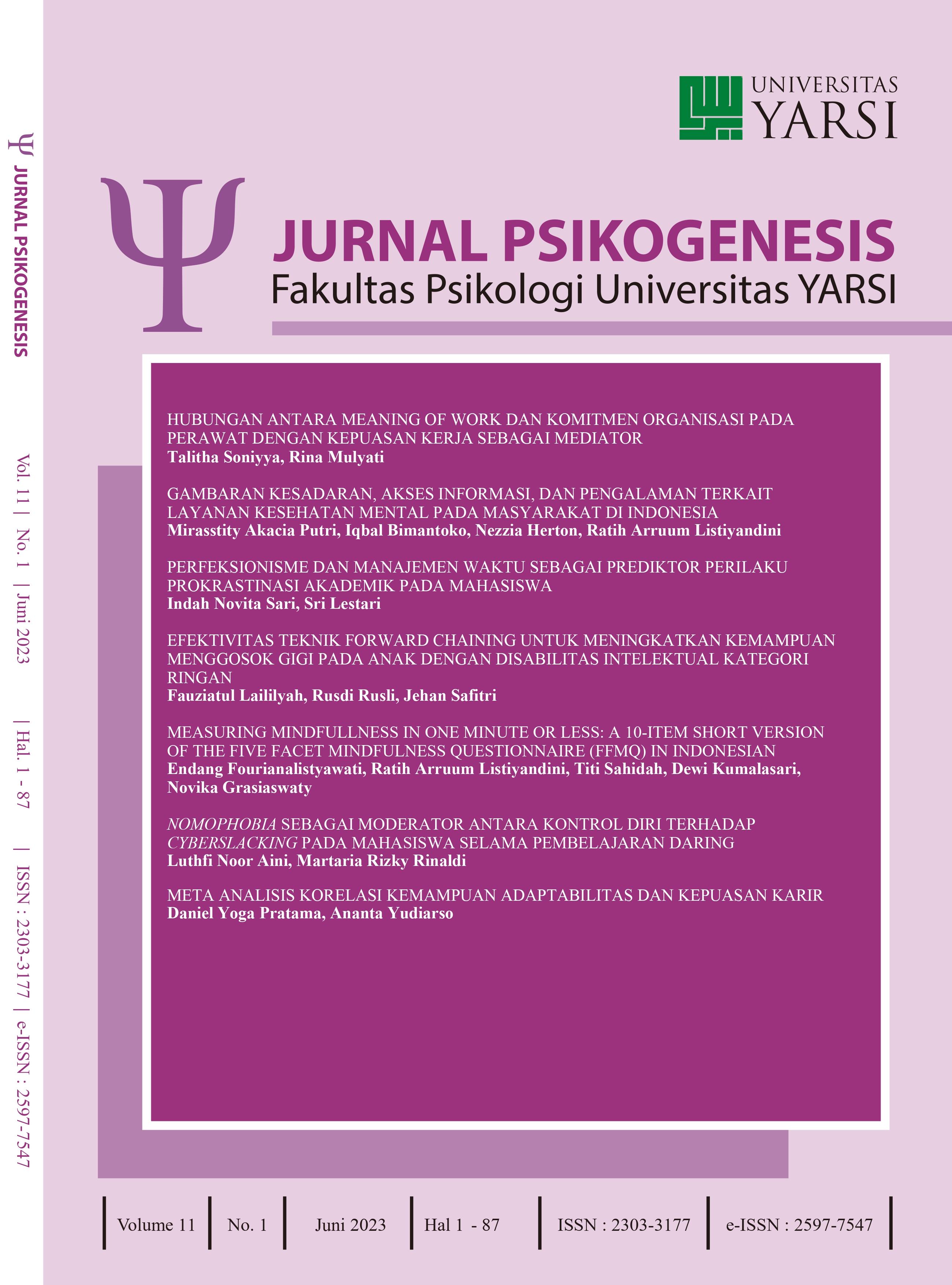Efektivitas Teknik Forward Chaining Untuk Meningkatkan Kemampuan Menggosok Gigi Pada Anak Dengan Disabilitas Intelektual Kategori Ringan
Kata Kunci:
Forward chaining, child`s dental development, teeth-brushing, intellectual disabilityAbstrak
The study aims to investigate the effectiveness of forward chaining technique in improving the teeth-brushing ability in children with mild intellectual disability. The hypothesis is that the chaining technique with forward chaining method is effective in improving the teeth-brushing ability in children with mild intellectual disability. Intellectual disability is a disorder during a period of development characterized by deficits in conceptual, social and practical aspects of daily life. The forward chaining technique is a chaining method in which each activity is arranged coherently and becomes a small series by teaching the first steps to success. The research method was a quasi-experiment with one group pretest-posttest design, using the purposive sampling technique with the criteria of children with mild intellectual disability, aged 6-11 years, experiencing barriers to intellectual functions, being adaptive, and unable to brush their teeth. Data were collected using assessment, observation and interviews. The assessment test tools were the CPM and Binet tests. The instrument was an observation sheet. Data were analyzed using the Paired Sample t-Test with a result of 0.04, so the Ha was accepted. It is concluded that the forward chaining technique is effective in significantly improving the teeth-brushing ability in children with mild intellectual disability.
Referensi
APA. (2018). Dsm-5-TR TM. In Angewandte Chemie International Edition, 6(11), 951–952. American Psychiatric Association.
Azizah, R., Sani, Y., & Vernanda, G. (2021). Efektivitas Teknik Task Analysis Dalam Meningkatkan The Effectiveness Of Task Analysis Techniques In Increasing The Ability To Brush The Teeth In 7th Grade Students With Visual Impairment In Slb A Bina Insani. 1, 1–6.
CDC. (2022). Fact About Inttellectual Disability. In Centers for Disease Control and Prevention (National C). Centers for Disease Control and Prevention. https://www.cdc.gov/ncbddd/developmentaldisabilities/facts-about-intellectual-disability.html
Dahlan, M. S. (2008). Seri Evidence Based Medicine: Statistik Untuk Kedokteran dan Kesehatan Edisi 3. Salemba Medika. https://www.google.co.id/books/edition/Statistik_untuk_Kedokteran_dan_Kesehatan/Abh5OaO3qlMC?hl=en&gbpv=1&dq=statistik+shapiro+wilk&pg=PA53&printsec=frontcover
Damastuti, E. (2013). Pentingnya Program Bina Diri bagi Anak Tunadaksa. Journal of Chemical Information and Modeling, 53(9), 1689–1699.
Gravetter, F. J., & Forzano, L.-A. B. (2019). Research Methods for the Bahvioural Sciences. In Cengage (Vol. 53, Issue 9).
Hastjarjo, T. D. (2019). Rancangan Eksperimen-Kuasi. Buletin Psikologi, 27(2), 187. https://doi.org/10.22146/buletinpsikologi.38619
Martin, G., & Pear, J. (2019). Behavior modification: What it is and how to do it. In Behavior Modification: What It Is and How To Do It. https://doi.org/10.4324/9780429020599
Miltenberger, R. G. (2012). Behavior modification: Principles and procedures (2nd ed.). In Behavior modification: Principles and procedures (2nd ed.). https://doi.org/10.1080/01431161.2016.1204478
Moniru, S., Rosita, W., Rita, S., & M, N. (2021). Kegiatan Kolase Sebagai Persiapan Menulis Anak Tunagrahita Ringan. Pendidikan Guru Pendidikan Anak Usia Dini, 3, 64–65.
Nuryadi, Astuti, T. D., Utami, E. S., & Budiantara, M. (2017). Buku Ajar Dasar-dasar Statistik Penelitian. Sibuku Media.
Putra, M., & Kasiyati. (2019). Meningkatkan Kemampuan Merawat Diri Dalam Keterampilan Menggosok Gigi Dengan Menggunakan Model Direct Instruction Pada Anak Tunagrahita Sedang. Jurnal Penelitian Pendidikan Khusus, 7(157), 235–242.
Salsabila, A., & Puspitasari. (2020). Faktor-Faktor Determinan Yang Mempengaruhi Prestasi Belajar Siswa. Pandawa: Jurnal Pendidikan Dan Dakwah, 2(2).
William, & Hita. (2019). Mengukur Tingkat Pemahaman Pelatihan PowerPoint. JSM STMIK Mikroskil, 20(1), 71–80.
Unduhan
Diterbitkan
Cara Mengutip
Terbitan
Bagian
Lisensi
Hak Cipta (c) 2023 Fauziatul Laililyah, Rusdi Rusli, Jehan Safitri

Artikel ini berlisensiCreative Commons Attribution-NonCommercial-ShareAlike 4.0 International License.
Authors who publish with this journal agree to the following terms:- Authors retain copyright and grant the journal right of first publication with the work simultaneously licensed under a Creative Commons Attribution License that allows others to share the work with an acknowledgement of the work's authorship and initial publication in this journal.
- Authors are able to enter into separate, additional contractual arrangements for the non-exclusive distribution of the journal's published version of the work (e.g., post it to an institutional repository or publish it in a book), with an acknowledgement of its initial publication in this journal.
- Authors are permitted and encouraged to post their work online (e.g., in institutional repositories or on their website) prior to and during the submission process, as it can lead to productive exchanges, as well as earlier and greater citation of published work (See The Effect of Open Access).

 Fauziatul Laililyah
Fauziatul Laililyah
 Universitas Lambung Mangkurat
Universitas Lambung Mangkurat










